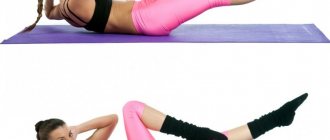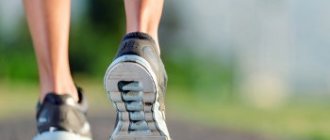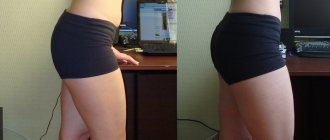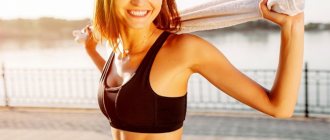Yoga classes make your figure slim, and with our set of exercises, your hips and buttocks will become elastic and beautiful.
Any figure should always be supported. This is especially true for body parts such as thighs and buttocks. In fact, doing this is not so easy, but it is possible. There are many different ways to lose weight, but today we will look at yoga exercises for the hips and buttocks.
This set of exercises has its own characteristics. Let's find out what are the benefits of yoga.
Benefits of yoga
Yoga can really help you lose weight. You choose which exercises you like best, energetic or measured. Such gymnastics helps restore balance in the body. Any fat deposits in different parts of the body are a consequence of internal imbalance, if this is corrected, then the fat deposits will disappear.
By practicing yoga, a person does not need to torture himself with grueling diets. Yoga itself is not capable of changing the shape of the hips and buttocks; it removes toxins from the body and returns the body to its natural beauty. Yoga improves blood circulation throughout the body.
Is yoga effective?
The effect of techniques developed over centuries is deeper than that of ordinary fitness. They work on the entire body, starting with the endocrine system. Regular exercise improves hormonal balance, accelerates all metabolic processes in the body, improves the functioning of the intestines and abdominal organs, and qualitatively strengthens the muscles.
1) Compliance with yamas and niyamas.
According to a treatise compiled by the sage Patanjali in the 2nd century BC. e., to achieve enlightenment you need to go through eight stages, or steps. And asanas, the most famous stage in the modern world, are only the third after yama and niyama.
– Yama is moral commandments, ethical rules designed to teach a person to exist harmoniously in the outside world. According to Patanjali, there are five of them: ahimsa (non-violence), satya (truthfulness), asteya (non-stealing), brahmacharya (chastity, moderation), aparigraha (renunciation of attachment).
– Niyama are spiritual principles that turn a person to the inner world. Among them are shaucha (purity), santosha (modesty, contentment with the present), tapas (self-discipline) and others.
You can move on to the third stage, asanas, only after completing the first two.
2) The right approach to nutrition. Yoga is combined with Ayurveda, a related science according to which well-chosen food helps cure diseases and improves health. Food also affects the state of mind and emotions.
As an alternative, you can use the system of Marva Ohanyan (there are many of her followers among practicing yogis in Russia). A doctor, biochemist, she studied proper nutrition, cleansing the body, fasting for many years and developed her own system.
Ayurveda regulates the time of eating (at different times of the day - different strengths of the digestive fire), recommends selecting types of practices depending on the person’s constitution (dosha) and his current state.
You can choose any other approach to healthy eating: partial restriction, vegetarianism, raw food diet, various types of fasting.
3) Performing shatkarmas - special cleansing techniques described in ancient yogic texts.
4) Regularity and consistency of classes. Along with perseverance and perseverance in mastering asanas, breathing and meditation practices, this will help to form a beautiful, healthy figure and consolidate the result.
What do you need for classes?
First of all, you need to buy comfortable cotton clothes. You will do the exercises barefoot in different poses. The floor should not be slippery and there should be a mat at hand.
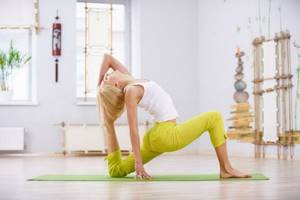
You need to do exercises on an empty stomach. If you have eaten, then wait four hours and start yoga. You need to drink water 30 minutes before the start of classes. Do yoga in the morning after a shower or walk outside. It is not advisable to do exercises before bed, as you may not fall asleep later.
Basic rules of yoga
In order to actively begin classes, you first need to know some points:
- Yoga classes can replace exercise, but if you can’t find time in the morning, you can move them to the evening, for example, from 19.00 to 20.00. The main thing is that if you want to achieve good data in the shortest possible period of time, you need to practice every day.
- During menstruation, it is advisable for girls to refrain from doing exercises for the first 3 days. And in the future, continue the minimum program (without twisting and complicated asanas). Once the “days” are over, you can get back on track.
- It is necessary to perform the poses in the most comfortable clothes. If for fitness you most often need tight-fitting clothes, then here you can be absolutely in “free flight” by choosing a tracksuit or any light knitted clothing.
- Sneakers and sneakers are inappropriate in yoga, since the classes are aimed at developing the feet and feeling the strength of the legs from toes to toes. So, practice barefoot in socks.
- In yoga there is almost no special equipment for practicing. Typically, you will need a mat or yoga mat, a support block, and a strap. The latter items are most often required by beginners.
- Support blocks in the form of “bricks” made of wood (most often) are needed for performing complex asanas so as not to get injured, and if you lack flexibility in the lower back, “enter” into the asana gradually - first leaning on the blocks, and then going lower.
- A belt is required in the absence of the necessary stretching and for performing asanas in order to gently stretch the arms and legs.
A set of asanas to strengthen the hips and buttocks
To reduce the size of your butt, a set of exercises should be performed daily. If you have the willpower, then do the exercises yourself at home, otherwise, ask a trainer for help. At the very beginning of yoga, you must do breathing exercises.
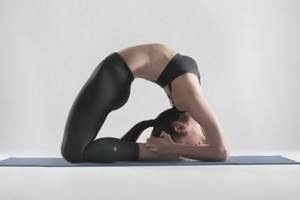
The first time you will not be able to do asanas, since the muscles are not stretched enough, over time, you will see the result, regardless of your age.
What you need to know about fat burning, oxygen and weight loss
Aerobic exercise is needed to start the weight loss process. During it, fat oxidation occurs, which is necessary for fat burning. Aerobic exercise is a mode of energy production during which ATP (the fuel for energy creation) is produced in the presence of oxygen.
How does this mechanism work? Let's turn to biochemistry.[2]
At the beginning of any physical activity, the body begins to use up the previously accumulated supply of ATP. However, it only lasts for a few seconds. Next, the body begins to use creatine phosphate to synthesize new ATP from it. But creatine phosphate reserves also do not last long. After this, anaerobic glycolysis begins - a process when ATP is synthesized without the use of oxygen.
This energy production process occurs during the initial stages of intense muscular work. Its byproduct is lactate from pyruvic acid (lactic acid). The pain that occurs in the muscles some time after exercise is due to the accumulation of this acid in the muscles.
During prolonged physical activity of low intensity, the process of aerobic lipolysis is launched, that is, the process of fat oxidation. It occurs only under aerobic conditions, that is, it requires oxygen. Aerobic lipolysis allows you to burn fat and starts the process of losing weight. That is why information about whether yoga is an aerobic activity or not is very important for understanding the weight loss-yoga connection.
Maximum oxygen reserve (MOR) is the amount of oxygen consumed by the body, including muscles. Its level indicates the training level of the student: the higher it is, the better physically prepared the person is.
That is, the amount of MCR is an opportunity to understand how muscles will work in an aerobic mode. After all, oxygen, as mentioned above, is a necessary component for starting the fat burning process. And without oxygen, fat does not burn.
A high percentage of maximum oxygen uptake reserve indicates that during aerobic exercise a person will be able to burn more fat, using it as fuel.
The following follows from this. Despite the fact that the above studies did not focus on the issue of weight loss, their results provide a concrete answer: fat is not consumed during yoga.
Locust
The first exercise is the locust asana. This yoga:
- Eliminates flatulence,
- Improves the functioning of the pancreas,
- Improves heart function,
- Strengthens the back muscles
- Improves the functioning of the digestive tract,
- Strengthens the gluteal and thigh muscles.
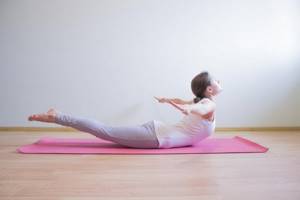
Doing this exercise is not that difficult. You need to lie on the floor on your stomach, your face looking at the floor, your arms lie along your body, palms down, without touching the floor. Then, lift your legs without bending them, chest and head. Keep your feet together and clasp your hands. Be sure to squeeze your butt to tone your buttocks and thighs in this pose and hold for one minute. This exercise can be done in different ways.
Firmer legs and thighs with yoga
Any woman tries not only to reduce volume in the hips, but also to fight problems on the inner thighs, which without development very quickly become flabby, cellulite or “ears” appear. The following yoga asanas will solve such problems by making your thighs toned and elastic.
Chair Pose
An asana that actively works the muscles of the buttocks and legs, actively stretches the back muscles:
- Place your feet side by side.
- As you inhale, raise your arms up and fold your palms.
- As you exhale, begin to slowly squat. You must remind yourself of a spring that has contracted.
- Slowly stretches out to return to its previous position.

There is no need to bring yourself to shaking legs - you can do the exercise in 30 seconds, 3 approaches. So it greatly contributes to the formation of a beautiful hip line and burning calories.
In yoga, the main thing is to work on relaxation. When you can breathe evenly for a minute while performing an exercise, it means that your muscles are already becoming more plastic and pliable, and you will soon see the result!
Bridge Pose
Ideal to perform after Chair Pose:
- Lie down on the floor and relax.
- Bend your knees and place your feet next to your pelvis.
- As you exhale, lift your pelvis off the floor so that your knees form a 90-degree angle. The buttocks should be pulled in, as well as the abdominal muscles, and the arms and neck should not be tense; the shoulders and head hold the “structure.”
- Hold the position for a minute.
- Lower your hips to the floor, and then your legs.
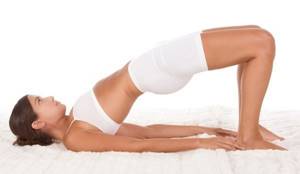
Downward Facing Dog pose with variable element
Very often, asanas are supplemented or complicated. This is just a more complicated version of the “dog”, since the work of the leg muscles is activated here:
- Form a “triangle” with your body, taking the “downward-facing dog” pose: as you exhale, on one side you lean on your hands (and not only your palms are a support, but also your fingers), on the other hand, on your toes.
- After fixing the position as you exhale, lift first one leg, then the other. Hold each leg lift for at least 15 seconds.
Utkatasana
Utkatasana pose eliminates the “orange peel” on the buttocks and legs. Moreover, it helps to pump up the muscles of the chest and thighs. Here are the instructions for performing the asana:
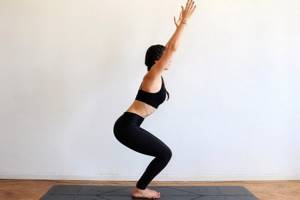
- Standing, close your feet.
- Squat down slightly so that your thighs are parallel to the floor.
- Keeping your back straight, lift them above your head without bending them.
- Stay in this position for half a minute.
By doing this exercise regularly, you will be able to hold the chair pose for a long time.
Which direction to choose
There are a lot of varieties of yoga - classical and modern, created on their basis. Any of them, when performed regularly and consistently, adjusts the body’s functioning so that the problem of obesity disappears. Intensely practicing yogis, who do not even set a goal to lose weight, are slim, lean, toned.
In the West, the most famous is hatha yoga - an ancient spiritual practice associated with the doctrine of harmony. Translated from Sanskrit, “ha” means “sun” and “tha” means “moon”. These are two opposite principles, feminine and masculine. Hatha is called upon to reconcile the opposites that exist in a person, to connect the spiritual and physical planes, to bring the human body to health so that it does not burden him in spiritual quests.
1) Ashtanga Vinyasa.
Practices dynamic transitions from asana to asana. Helps quickly burn fat deposits and tighten muscles, but is difficult for those who are overweight.
2) Bikram yoga (aka hot, or hot).
DETAILS: Artroker - instructions for use, price, reviews and analogues
An interesting direction that combines classes and a sauna: asanas and pranayama are performed at an air temperature of at least 37 degrees Celsius and high humidity. Followers of this trend believe that a heated body gets rid of excess fat faster, and ligaments at this temperature are more elastic and less susceptible to injury. Weight loss is facilitated by profuse sweating, which is inevitable at this temperature.
This style is not suitable for those with heart problems and the exercises should only be performed under the supervision of a qualified instructor.
Warrior II
Exercise Virabhadrasana II promotes:
- Cleansing the body
- Improving the respiratory system,
- Strengthening the muscles of the buttocks, abdomen and thighs,
- Strengthens joints and makes them mobile.
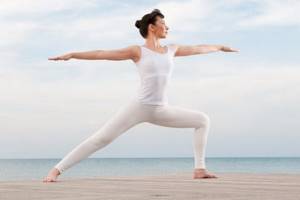
Thanks to this pose, a person loses weight significantly, his mood improves and his body is in harmony. This asana is suitable for those who have problems with the spine. It is done like this:
- While standing, spread your arms to the sides. Palms face down.
- Take a big step forward with your right foot and turn the same foot outward 15 degrees. Turn your left leg inward.
- Now do a squat on your right leg, pressing your heel firmly. The head should look towards the right leg, and the left leg should not move.
- Stay in this position for about minutes, keeping your body upright.
- Repeat the same with your left leg.
When doing this exercise, you need to tighten your gluteal muscles. A yoga pose will be effective when there is a visually straight line from the butt to the top of the head. In the beginning, you will find it difficult to do this exercise, so you can lean on the wall.
Correct breathing in yoga
From time immemorial, in the East they believed that proper breathing can not only saturate the body with oxygen, but also heal from diseases and give a great mood. Therefore, in yoga, a section is dedicated to practicing breathing techniques - pranayama.
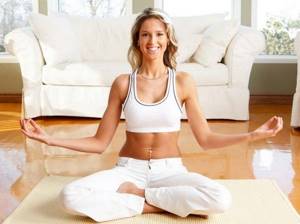
This is already the fourth level of practice, to which you need to grow, but in the initial stages it is enough to remember the basic nuances of proper breathing for successful practice:
- We use “lower” breathing and connect the diaphragm. This is exactly how children usually breathe: when they inhale and exhale, their stomach works, not their chest. As you grow older, stress and nerves affect a person, restructuring his breathing, making it chesty and fitful.
Important! As a result of this, the body does not receive enough oxygen, so yoga teaches you to breathe with your stomach: inflate it as you inhale and draw it in as you exhale.
- We breathe only through our nose. Exceptions are allowed only for runny noses, colds, or when the nose is stuffy.
- We breathe slowly, deeply. It is this technique that allows you to quickly saturate tissues with oxygen, which leads to their relaxation.
- Let's keep up the pace . Whatever exercise you perform (and especially when changing asanas), it is important not to stray from the chosen rhythm and not to hold your breath. It is also advisable to inhale during upward movements (raising your arms, straightening the spine), and exhale during bending, bending, that is, downward movements.
Breathing in yoga for beginners not only helps to achieve weight loss results at home, but is also important for meditation and strengthening the immune system.
Setu Bandhasana
This pose is also called the bridge. It eliminates migraines, helps fight insomnia, improves the functioning of the abdominal organs and stimulates the functioning of the endocrine system.
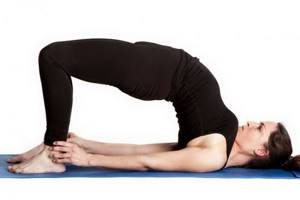
- Lie on the floor with your back, straighten your arms along the cable, and lower your palms down.
- Bend your legs, moving them towards your pelvis.
- Exhaling, lift your butt up.
- The hands need to be closed and they should lie on the floor under the butt, without touching it.
- The pelvis should be parallel to the floor.
- The shoulder blades need to be brought together and the chin pressed against the jugular cavity.
- Hold the pose for one minute.
- As you begin to inhale, lower your body down.
This exercise needs to be done slowly.
Metabolism: what is it in simple terms
Metabolism (metabolism) is the process of converting nutrients entering the body into energy. It consists of two interrelated processes: catabolism (the breakdown of complex substances into simple ones, leading to the release of energy) and anabolism (the formation of complex organic substances from simple ones).
Another important indicator showing the intensity of reactions occurring in the body is called basal metabolism. It allows you to find out the amount of energy needed daily by the body at rest to ensure its vital functions. The higher the basal metabolic rate, the greater the number of calories needed to support all processes occurring in the body.
Half Bow Pose
The half-bow pose tones the back muscles, has a positive effect on the spine and straightens the posture.
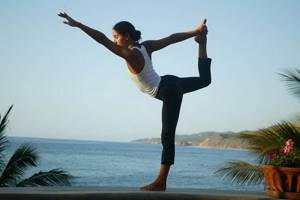
Lie on your stomach with your palms on the floor. You need to bend your knees so that your shins are vertical. Raise your torso, resting your palms on the floor, while your head should be at the same level as your feet. Exhaling, extend your arms towards your feet. It is important to bend well in the thoracic region. Hold this pose for one minute.
You may experience rapid breathing, do not worry - this is normal.
Myths about losing weight thanks to yoga
Attentive readers may have noticed one nuance: it is not known for certain which complexes were chosen for these studies. Maybe scientists used insufficiently active styles and this is what influenced the results of the work?
As if anticipating these doubts, scientists at the University of Wisconsin conducted another study in 2005, choosing the subject of power yoga - a highly active branch of yoga, consisting of complex ligaments and dynamic transitions from one pose to another. 15 participants who had sufficient experience in yoga and were physically ready for high-intensity training were selected specifically for this work.
However, even in this case the picture has changed insignificantly. It turned out that one yoga session burns about 144 calories - slightly more than slow walking.
Perhaps there was another reason for these disappointing results? Indeed, during these studies, very specific equipment was used: voluminous masks that the subjects wore while performing the exercises. Could this cause inconvenience for those involved and cause a decrease in performance indicators?
In 2007, a study was published, the organization of which excluded the possibility of error: it used the latest expensive equipment, which was not only highly accurate, but also comfortable for the subjects. Thanks to financial support from the National Institutes of Health, Long Island University Brooklyn and the T.H.
see all the changes occurring in it and calculate the exact amount of oxygen consumed. Secondly, the researchers carefully selected the training complex for the subjects. They chose an active form of yoga: the Ashtanga Vinyasa style, known not only for its high intensity, but also for its standard sequence.
The lesson consisted of a 28-minute “Surya Namaskar” complex; Next came standing asanas, which were performed for 20 minutes; after – final savasana for 8 minutes. 20 advanced practitioners were selected for the study: 2 men and 18 women. The selection criterion was knowledge of the Surya Namaskar sequence and the ability to perform such complex asanas as headstand.
During the session, the exact amount of oxygen that the subjects consumed was measured; exhalation of carbon dioxide and metabolic activity. To eliminate any errors, in this chamber, in addition to practicing yoga, the subjects read books and walked on a treadmill in two modes: medium and high intensity.
But this study, carefully and highly technically organized, and freed from all possible inaccuracies and errors, confirmed the already known idea. Even Ashtanga Vinyasa yoga, rightfully considered one of the most intense yoga deviations, does not meet the minimum recommendations for aerobic exercise.
It turns out that even the most active styles of yoga are not aerobic training, that is, they do not promote fat burning during exercise. But perhaps yoga helps you lose weight due to something else. After all, as you know, there is another way to lose weight - to “accelerate” your metabolism.
Does yoga help you lose weight?
Those who do yoga have a beautiful figure. However, apart from yoga, they are very careful about their diet and lifestyle. It is important to drink plenty of clean water and lead an active life. Try to walk a lot and quit bad habits.
When you do yoga, perform each exercise well and tighten all the muscles. When doing yoga, a person should not rush, otherwise the exercises will have little effect. Watch your breathing. It would be useful to do breathing exercises before yoga. Therefore, my dears, if you want to get your buttocks back to normal, take yoga seriously. Follow the additional recommendations and then you will see the result. Alice was with you, see you soon.
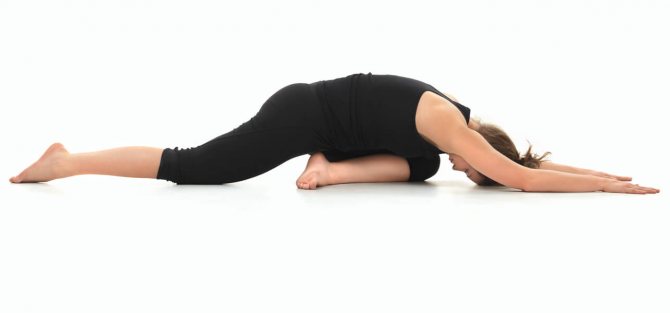
Have you ever wondered how to tighten your gluteal muscles at home? Did you know that you can pump up your butt with yoga?
Read this article to the end and you will find out what exercises will help you pump up seductive buttocks in a minimum amount of time.
Mountain Pose or Tadasana
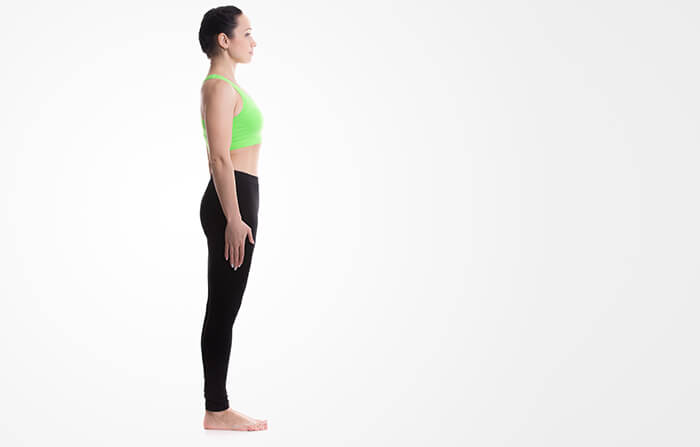
One of the best asanas designed to strengthen not only the thighs and buttocks, but also the calf muscles.
- Stand up straight;
- Straighten and tense your knees, press your feet to the floor, tighten your abdominal muscles;
- Feet together. Feet should be no further than 2 cm apart;
- The arms are lowered along the body, the shoulders are straightened;
- Maintain this position for 2 minutes;
- Rest.
Contented Child's Pose or Ananda Balasana
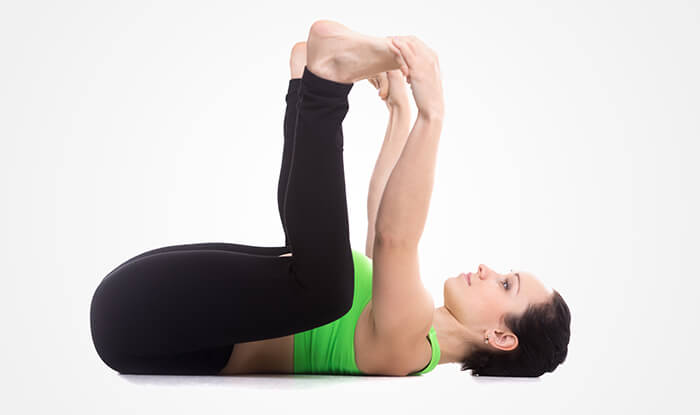
This asana is a variation of Balasana. Helps improve digestion, give energy and stimulate the nervous system.
- Lie on your back;
- Pull your knees toward your stomach so that your shins are perpendicular to the floor;
- Stretch your arms up and grab your feet;
- Lightly pressing your hands on your feet, direct your knees towards the floor;
- Maintain the asana for 15-20 seconds;
- Return to starting position and repeat.
Cobra Pose or Bhujangasana
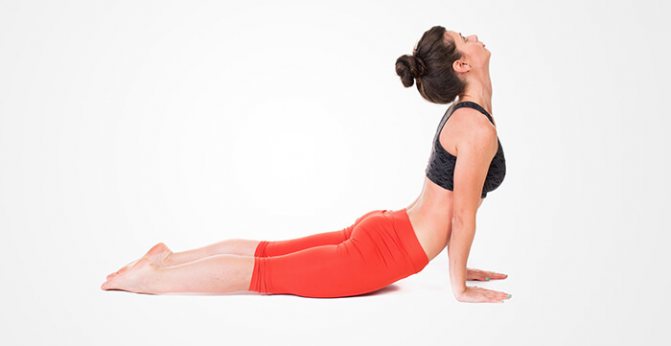
This asana perfectly strengthens the muscles of the buttocks. Not only will it help tone your buttocks, but it will also reduce pain from kidney stones and strengthen your lower back.
- Lie on your stomach;
- Press your feet tightly to the floor;
- Tighten your thighs and lower your leg lifts to the floor;
- Begin to lift your body up without lifting your lower body from the floor;
- Point your body back;
- Continue lifting until you feel a stretch;
- Stay in this position for 10-15 seconds.
Warrior Pose or Virabhadrasana
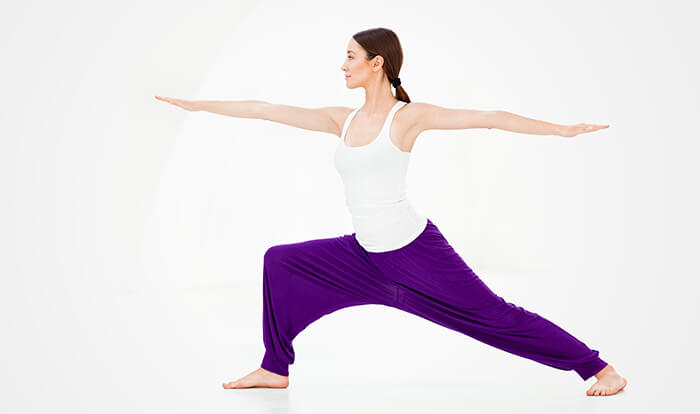
Warrior pose is one of the best asanas for stretching the buttocks, which gives tone. By practicing this asana regularly for 3 months, you will certainly achieve firm thighs and buttocks.
- Stand up straight;
- Step your right leg forward and bend your knee;
- Turn your left foot so that it forms a 90-degree level with your right leg;
- Extend your arms forward;
- Palms facing down, gaze forward;
- Stay in this position for 75-90 seconds;
- Rest and repeat.
Pigeon Pose or Kapotasana
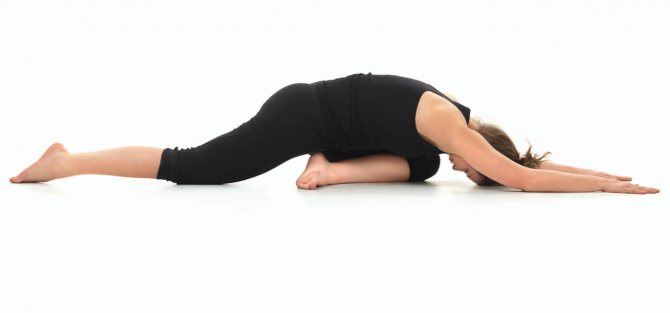
Pigeon pose works all the muscles of your body, in particular it improves the flexibility of your legs and develops your hip flexors. Football players often perform this asana to maintain thigh muscle tone.
- Stand up straight;
- Get down on your knees;
- Extend your right leg back;
- Extend your leg back until your right thigh touches your left foot;
- Socks pulled up;
- We lean forward;
- Stay in this position for 25-30 seconds;
- Switch legs and repeat.
Perform this set of asanas for beginners and strengthen not only the buttocks, but also the deep core muscles. Let us know if you know any other asanas for the buttocks. Leave a comment below.
Exercise for the buttocks
Walking or walking on your buttocks helps:
- Improve blood circulation in the lower abdomen,
- For prostatitis,
- Prevent the development of radiculitis,
- Tighten your gluteal muscles
- Reduce the amount of subcutaneous fat at the waist,
- Increase the elasticity of the abdominal muscles,
- Form a beautiful silhouette of the hips,
- For constipation and urinary incontinence.
Do the exercise like this: sit straight on the floor, back straight, elbows bent. Spread your legs shoulder width apart. The buttocks alternately rise and move forward along with the corresponding leg. The knees remain straight. Elbows are pressed tightly to the sides. The initial number of steps forward is 10, then you need to take the same number of steps back without turning around. Over time, the number of steps is increased, and the duration of the exercise is about 25 minutes in two repetitions.
It is not only beautiful, but also good for the spine.

Ardha Dhanurasana.
This asana will help determine how balanced the gluteal muscles are developed on the right and left. Lie on your stomach, press your forehead to the folded blanket and, as you inhale, raise your legs, bending your knees at an angle of 90 degrees. Keep your feet parallel to the floor, above your knees. With the fingertips of both hands, touch the gluteus maximus muscles on the right and left and tense these muscles, as well as, slightly, the muscles of the center of the body. Gently rotate your legs, pressing them together to maintain tension. On your next inhalation, pull your knees and shins up as far as possible. You won't raise them too high, but the main thing is to make sure that your thighs and glutes are contracted evenly. If you notice an imbalance, push the heel of your “lazy” leg into the heel of your stronger one to work on the weak gluteus muscle. Stay in this position until you have diagnosed the condition of your buttocks. Exhale and relax.
Top 7 asanas for toned buttocks at home
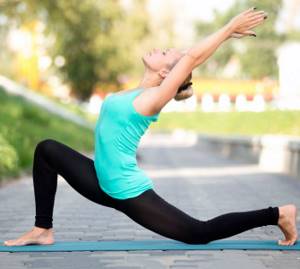
Have you ever heard of yoga butts? If you see them once, you will definitely want the same ones. Such buttocks are elastic and beautifully shaped. A certain set of asanas will help you achieve your goal. We have put together a set of 7 effective asanas for practicing at home.
When we talk about yoga, we mean exercises that relax the body and mind. However, in addition to this, yoga practice can also serve to strengthen muscles. Every girl wants to have a beautiful, toned butt. Together with elastic buttocks you will gain self-confidence. Below are asanas that will help you achieve the desired results.
Yoga for buttocks – 7 effective asanas
- Salabhasana (Grasshopper Pose);
- Purvottanasana (Inverted Plank Pose);
- Anjaneyasana (Crescent Moon Pose);
- Virabhadrasana 2 (Warrior Pose 2);
- Trikonasana (Triangle Pose);
- Ardha Chandrasana (Crescent Moon Pose);
- Natarajasana (King of Dance Pose).
Salabhasana (Grasshopper Pose)
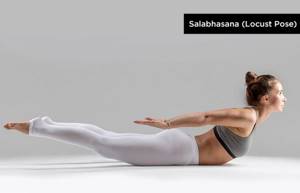
Salabhasana or Grasshopper Pose looks quite simple to perform, but is actually quite difficult to do correctly. It is necessary to include this asana in your training to achieve results. Practice Salabhasana in the morning on an empty stomach. This asana belongs to the basic level of Vinyasa yoga. Hold it for at least 30-60 seconds.
Purvottanasana (Inverted Plank Pose)
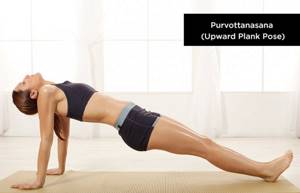
Purvottanasana or Inverted Plank Pose is an intense stretching of the front of the body. It is best to practice it in the morning on an empty stomach. If it is not possible to perform the asana in the morning, then you can do it in the evening, but provided that the last meal was 4-6 hours ago. Maintain the asana for 30-60 seconds. This asana belongs to the basic level of Vinyasa yoga.
Does yoga burn calories?
In 2005, several experiments were conducted [1] that answered the questions:
- “Does yoga meet the minimum aerobic exercise requirements recommended by global health organizations?” And
- “How intensely are calories burned during yoga practice?”
One of them was conducted by researchers at Texas State University in the Department of Sports Medicine.
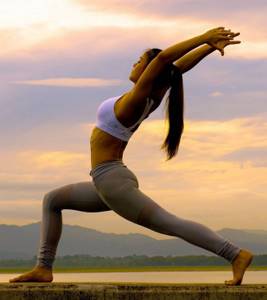
In their work, they measured oxygen levels during various activities: yoga training, fast walking, and sitting on a chair. The experiment involved 26 women who had practiced yoga for one month or more. The yoga class included the Surya Namaskar (Sun Salutation) complex and was structured in the form of a standard workout in a fitness center. Each training session lasted 30 minutes.
Measurements were taken before, after and during the lesson. For this, special masks with tubes connected to computing equipment were used. This made it possible to compare the difference in oxygen absorption by the body during the rest period and at maximum load, as well as to calculate the maximum oxygen absorption reserve (MOC).
The results were compared with the recommended values of the American College of Sports Medicine, which recommends training using 50-85% of the maximum oxygen uptake reserve.
As a result, Texas State University found the following: when walking quickly, subjects used 45% of the maximum oxygen reserve, and when doing yoga - only 15% (that is, 35% less than the lower limit). Of the entire yoga complex, the most dynamic part turned out to be “Surya Namaskar” - during “Salutations to the Sun,” the percentage of oxygen absorption increased to 34%, that is, almost close to the results from fast walking.
Another study on the same topic was conducted by scientists at the University of Wisconsin.
They recruited 34 women who had never practiced yoga before and had no experience of regular fitness training. The participants were divided into two groups. The first, as before, did not engage in any special physical activity, and the second began to perform a 55-minute yoga routine three times a week. The study lasted 2 months.
That is, these studies confirm that yoga is not an aerobic workout and does not even reach the lower limit of the recommended percentage of MOC.
DETAILS: Derinat spray 0.25% 10 ml price 450 rubles in Moscow, buy Derinat spray 0.25% 10 ml instructions for use, reviews in the online pharmacy
But why are these works so important within the framework of the issue of “yoga and weight loss”?
What is aerobic exercise and how does it help you lose weight?
How does MOC affect fat burning?
Understanding these issues will allow you to better understand the full value of the research conducted.
Are there any side effects to practicing yoga?
Yoga for the back and spine under the guidance of an experienced instructor has no side effects, not to mention classes to achieve other goals.
Have you ever used yoga as a way to strengthen your butt? Did she help you? Elastic, pumped up buttocks give every woman self-confidence. To achieve amazing buttocks, try revising your training program and including the above asanas in it. Let's get to work!
The absence of excess weight is not always an indicator of a beautiful and slender silhouette. Many women remain dissatisfied with their figure even when they have no problems with excess weight. The reason for this is subcutaneous fat accumulated in the buttocks and thighs. It not only spoils the silhouette, but also makes the skin flabby and leads to loss of muscle tone. This does not add any attractiveness. Subcutaneous fat appears either due to the lack of exercises for this problem area in the training program, or when a woman leads a sedentary lifestyle.
You can get rid of this flaw even at home. The main thing is to choose the right program. Yoga has demonstrated the greatest effectiveness in the fight against subcutaneous fat on the thighs and buttocks. It is not necessary to become a guru and comprehend all the practices. There are several asanas available for mastering and performing that every woman can do. Of course, they will only work if you follow a regular diet and follow a diet, since food is the main source of fat that accumulates under the skin.
Yoga for belly slimming
Almost every woman suffers with her stomach - either it is too round, or the suffering is caused by sagging skin after childbirth. There are solutions to every problem in yoga, and if you perform the exercises regularly, the results will become noticeable within a week.
Before performing exercises, a warm-up is required to prepare the body for new loads. Each position must be fixed for at least a minute, and 2 approaches must be performed.
Maximum extension pose or uttanasana
The ideal exercise that works specifically with the abdominal muscles:
- Standing straight as you inhale, raise your arms, stretching your spine, and exhale, smoothly lower down to your feet, as if folding into a rectangle.
- Feel the whole body, the abs (the stomach must be pulled in) and fix the position.
- To exit the pose, inhale and slowly rise to the original position, but now with your arms down.

Boat pose
An exercise that directly acts as an active fat burner in the abdominal area. In addition, by performing this asana, you tone your entire body:
- Sit on the mat and place your feet bent at the knees.
- Take a deep breath and move your straight back back about 60 degrees. If you perform the exercise on your own, then it is better to control yourself in front of the mirror so that your back does not round during the asana.
- As you exhale, lift your legs off the floor and slowly straighten them until your toes are at eye level. Your arms must be extended parallel to the floor and the position fixed.
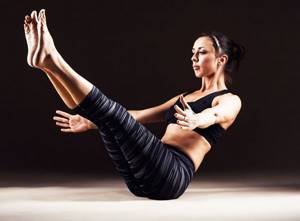
Staff Pose or Low Support
An asana that helps activate all the keys of the body to combat fat deposits in the waist area. At the same time, posture improves and the muscles of the arms and legs are strengthened:
- Lie on your stomach, get ready to push with your arms.
- As you exhale, slowly rise up using your palms and toes. At the same time, your hands, fingers and palms should firmly hold your body, that is, they should be “pressed” into the floor (mat) as much as possible.
- Lock the position.
- Exit the asana smoothly, not at the end of your strength, but feeling significant work of the abs. Take a deep breath and exhale – relax for a couple of minutes.

Downward Facing Dog Pose
This asana activates your abdominal muscles:
- Stand up straight and slowly lower yourself while exhaling, focusing on your hands.
- Spread your fingers wide, rest on them and on your palms, forming a triangle in this pose.
- The abdominal muscles should be pulled in, the back should be as straight as possible: in this pose, a pleasant tension is especially felt in the shoulders, shoulder blades and abdomen.
- Exit the pose by smoothly moving your palms towards your feet. Slowly rise up, first forming a 90-degree angle, and then return to the starting position.
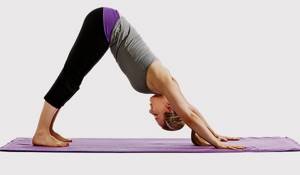
Locust pose
Excellent “working out” of the abs, back muscles, and back of the thigh:
- Lie on your stomach, stretch your arms back and clasp them (or you can keep them parallel to the floor).
- Stretch your arms back and your legs up. Beginners can use walls as support to raise their legs as high as possible.
- When performing this exercise, the buttocks should be squeezed, the neck should not strain, and the main tension is in the abs, back, arms and legs.
- When you reach the “peak” of your capabilities, pause for a minute and relax, returning to your starting position.
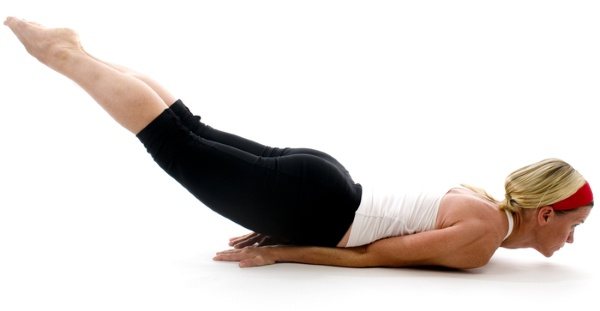
The ideal Locust pose looks like this:
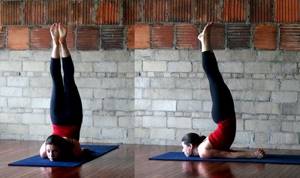
To achieve such results, you need to practice daily for several months.
Bow pose
Works great with the abs, the muscles of the back thigh, and the buttocks:
- Lie on your stomach, relax.
- Place your palms on the outside of your ankles and stretch as far as possible. Feel the stretch in your abs, arms, legs and thighs.
- Hold the position for a minute and repeat 3 times with a break of 10 seconds.
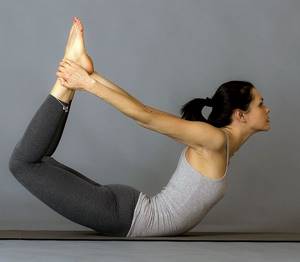
Cobra pose
This stretch is perfect after a cycle of asanas and for strengthening your back and abs. Lying on your stomach, lift yourself up on your arms (your hands should be located under your shoulders) and stretch up:
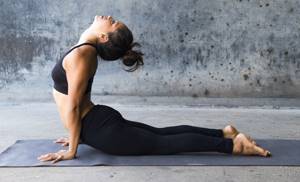
In this exercise, it is very important not to throw your head back too much and not to overstrain your lower back. You need to look up and feel the stretch, as this pose is often the final one - relaxing.
The position can be fixed from 30 seconds to 1 minute and repeated 3 times with a break of 5 seconds.
By performing these exercises, you can remove excess fat from the abdomen and sides, but yoga is not limited to this - it is universal, since almost every exercise involves not only the abdominal muscle group, but also the legs, arms or back, which allows you to adjust your body into a plastic, flexible state. Our next article will tell you about other methods of how to remove belly fat.
The best yoga exercises for legs and buttocks
Includes twelve yoga asanas that are aimed exclusively at working out problem areas. If you do this complex every day, you can soon forget about fat on your legs and buttocks. The main thing is not to give up practice and continue practicing as a preventive measure. In addition, it will have a positive effect on your overall physical fitness and mental balance.
Utkatasana
Performing this asana actively connects the leg muscles to the work. The buttocks and thighs are subject to the greatest load. The pose imitates sitting on a chair, which in this case is absent, but exists only in the imagination. The lack of support forces you to use your muscles to maintain your own body weight. Your own weight begins to be directed towards tension in the muscle groups of the pelvis and hips. The asana improves tone, trains, and strengthens the leg muscles.
Performance:
Get into the starting position called Tadasana. Bend your knees smoothly and lower your pelvis. The movement should be similar to that of you sitting in a chair or on a chair. Inhale and stretch your arms up above your head. Hold the position for several seconds, making sure your breathing is even, and then straighten up and return to the starting position.
Remember. You must always be attentive to how the body responds to the performance of the asana. Beginners are advised to try to go as low as possible and increase the depth gradually. When the pose begins to be easy, you can begin to sway to increase muscle stretch.
Virabhadrasana II
The pose is aimed at working the legs, but the greatest load falls on the inner thigh, which is an undeniable advantage. For beginners, this asana seems quite simple, but this is only the surface impression. It perfectly works those muscles that remain practically unused in everyday life. The advantage of the exercise is that they are involved in two different ways, and therefore the buttocks are also involved.
Performance:
The legs are spread wider than the hips. The right foot is turned outward, and the left foot is used to maintain balance. The center of the left foot should be in line with the right leg. The pelvis is lowered and the chest is rotated, straightening the arms to the side so that they form a straight line with the shoulders. They look ahead. Constantly monitor the correctness of their position. Breathe strongly, but slowly, and then relax, repeat everything on the other side.
Remember. To achieve better results, you need to work on stretching, lowering your pelvis as low as possible. The pose must be collected and balanced.
Natarajasana
One of the most graceful asanas, stimulating and stretching the hip flexors. In the dancing king pose, both internal and external muscles are worked simultaneously. The exercise is aimed at strengthening the lower part of the body, as it requires maintaining balance in a one-legged stance, tensing the muscles from the feet to the pelvis. Thanks to this, the hips open, blocked energy is released, blood flow improves, oxygen and nutrients flow.
Performance:
Become in Tadasana. The right leg is raised and brought back, directed so that the thigh is parallel to the floor surface. Bend the knee, grab the right foot with the right hand and stretch. When a stable position is assumed, the left arm is extended forward. With the palm you can do either Gyan Mudra or hold it straight. They look at the fingers of their left hand, maintain the pose for several minutes, breathing deeply, and repeat the asana on the other side.
Yoga classes at home for slimming thighs
Following are 12 easy yoga poses that you can do at home. I’ll say right away that WHEN EXACTLY you will gain slender and elastic thighs is unknown, because everything depends entirely on you, i.e. on how you follow the key success factors which are:
- Regularity of practice (ideally every day or at least 3 times a week)
- Gradual development (take your time)
- Focus (when doing yoga, don't do anything else)
- Relaxation (no, well, the muscles, of course, will tense, but in general, you should try to relax in the final poses, unless otherwise indicated).
If the poses don't work out well at first, don't worry! Over time, everything will work out, well, that is, they will turn out a little better. And by the way, don’t forget to breathe!
So, let's go, the "hips" are waiting!
Exercise 1: Chair Pose (on which one sits) - Utkatasana
It looks simple, but chair pose can still require a lot of effort on your legs, especially at the initial stage (which, in general, is what we need). Over time it will become easier, flexibility will also increase.
Technique: Stand straight with your feet together. As you inhale, raise your arms above your head. Keeping your arms overhead, as you exhale, bend your knees until you reach a position as if you were sitting on a chair (which, in fact, you are not). That is, you need to reach a position where your knees are bent at approximately 90 degrees. Keep your knees together. This may be difficult to do at first, so bend to an acceptable angle. This is the final position.
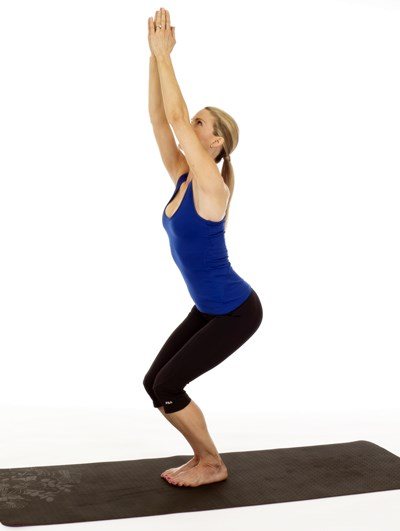
Stay in the final position for 30-60 seconds, breathing evenly, then as you exhale, return to a standing position, inhale, and as you exhale, lower your arms to your sides. You can repeat it 3-5 times, just don’t overexert yourself.
Exercise 2: Pavanmuktasana (variation)
Lie on your back, arms along your body, legs almost together. Relax. Close your eyes.
As you inhale, lift your left leg so that it is perpendicular to the floor (or as much as you can), with your foot “looking” at the ceiling. At this time, do not lift your right leg off the floor (but try not to strain your right leg).
As you exhale, tensing your abdominal muscles, bend your left leg at the knee so that your thigh reaches your chest. At the same time, clasp your left foot with your hands, raise your head, and touch your left knee with your nose. Hold for 5-10 seconds (you can hold your breath or breathe normally).
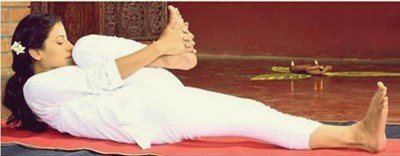
Take a deep breath and lower your head to the floor. As you exhale, straighten your left leg and lower it to the floor. Repeat the same with your right leg.
Exercise 3: Deep Squats
Stand straight, feet 30 cm wide, arms forward, in front of you, parallel to the floor, palms facing down.
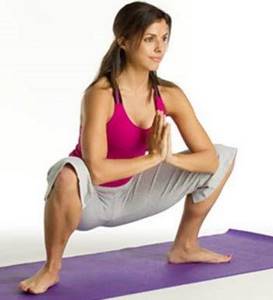
Inhaling deeply, squat down and try to keep your knees bent at a 90-degree angle. After a full squat, exhale and immediately return to the starting position.
Exercise 4: Ananda Balasala or Happy Child's Pose
The exercise is relatively simple. But it is better not to do it on a hard floor.
By the way, there is an exercise with a similar name, but a different technique - child’s pose (Balasana).
So, lie down on your back. As you exhale, bend your knees and bring them to your chest. Grab your feet with your hands (closer to your toes). Your hands should be in front of your shins, and you should hold your feet on the outside.
Inhale, and as you exhale, pull your feet towards you, while “spreading” your shoulders on the floor. Continue moving towards yourself, spreading your knees towards your armpits. The ankles are above the knees.
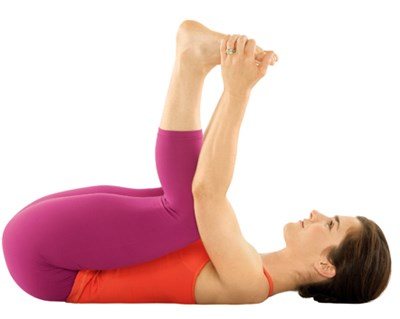
Stretch your back along the floor, trying to touch the floor with your tailbone. In the final position, hold for a minute if possible, breathing normally, then, as you exhale, gradually release your feet, straighten your legs, and relax.
Exercise 5: Virabhadrasana 1 or warrior pose (option 1)
Virabhadrasana perfectly strengthens the legs and removes excess fat from the waist and hips. Stand up straight. As you exhale, spread your legs apart, about a meter apart.
As you exhale, turn your left foot 90 degrees (toe points to the left), and your right foot a little (45 degrees).
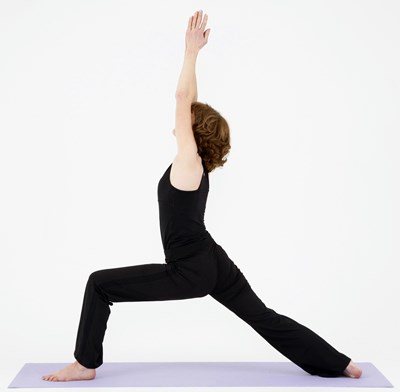
Inhaling, raise your arms above your head, palms together, and as you exhale, turn your torso to the left 90 degrees and bend your left leg again to an angle of 90 degrees, moving your body forward (i.e., to the left of the original position). Hold in the final pose for 3-5 full breaths (inhale-exhale), then as you exhale, straighten your left leg, return to the starting position, then do the same to the right side (you can keep your arms raised up).
Exercise 6: Virabhadrasana 2
The principle of execution is the same as in warrior pose 1, only in the final position we hold our hands not above our heads, but to the sides, parallel to the floor. This pose is called Virabhadrasana 2.
The shameful secret of yoga. What are modern teachers hiding?
It turns out that a fast metabolism will allow you to stay slim, minimizing the influence of such a dangerous factor for your figure as high-calorie food. Therefore, if yoga actually increases your metabolism, this would mean that it promotes weight loss. But what is the reality?
- Larry Payne, MD, temptingly promises in his book “Yoga for Dummies.”
– the founder of her own yoga style, Tyra Stiles, echoes him in the book “Slim Calm Sexy Yoga”. But can these statements be believed? After all, when giving them, the authors do not cite any source. And are there any scientific studies on the effects of yoga on metabolic rate?
Such a study was conducted, but for some reason its results were not advertised. This is possible for two reasons. Either yoga teachers who promote the idea “yoga speeds up metabolism” did not consider it necessary to study the relevant materials. Or for some reason they decided to keep silent about them. In any case, it has been known for 10 years that yoga not only cannot speed up metabolism, but rather, on the contrary, can slow it down.
Savasana or corpse pose. In this pose, yogis train to let go of all kinds of worries, disturbances, tensions, pressures...
The study lasted six months. Its results were impressive. First, it turned out that yoga does not have a positive effect on increasing metabolic rate.
Secondly, it was found that the practice of yoga, on the contrary, reduces basal metabolism by 13%.
Thirdly, when the results were divided by gender, it turned out that the decrease in basal metabolism in women occurred by as much as 18%, while in men it was only 8%. It turns out that exercise affects the basal metabolism of women more than the corresponding indicator for men.
What causes this decrease in basal metabolism? A group of researchers stated that yoga slows down physiological functions. As a result, the calorie requirement of yoga practitioners is reduced. Therefore, if exercisers do not review and change their diet, this can subsequently lead to “weight gain and the appearance of fat deposits.”
The results of this study are shocking and surprising. After all, hand on heart, one cannot help but notice that complete yoga is extremely rare. Most often, yoga teachers are athletic and fit. And those who exercise regularly, contrary to what scientists say, begin to look slimmer and more attractive over time.
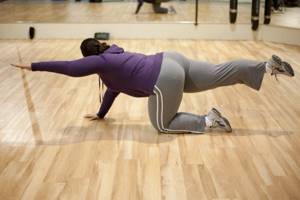
It turns out that yoga really allows you to lose weight, but this is connected not with physiology, but with psychology.
It turns out that the impact of yoga on the psyche is very great. Perhaps this influence can be used to combat excess weight?
How does yoga protect against stress eating?
It's no secret that one of the reasons for the appearance of excess fat is the “eating” of stress. It leads to overeating, consuming too many calories and, consequently, excess weight.
Therefore, if a person manages to reduce the level of anxiety, then one of the factors influencing the appearance of excess weight will be eliminated. And in combination with moderate physical activity and a healthy diet, it will be possible to completely get rid of unwanted kilograms.
It should be noted that yoga is one of the most effective means of combating stress. Some researchers have devoted entire books to this topic.
For example, in 1978, the work “Stress and its management by yoga methods” by a doctor from the Hindu University in Benares, Katil Udupa, was published. There he describes the results of his many years of research and says that the practice of yoga can reduce high levels of hormones that arise as a reaction to stress.

This means that yoga practice will help combat anxiety and protect against stress-induced overeating. But the question still remains open: does yoga allow you to lose weight? To find the answer, you need to look at this topic from a different angle.
Benefits of Yoga
The effectiveness of classes will be noticeable only if you regularly perform the techniques and review your approaches to nutrition. But already from the first workout you will feel “muscular joy,” as the physiologist Pavlov said - a new, more flexible, stronger, toned body has begun to form.
The advantages of this type of physical activity are as follows:
- Constant focus on breathing and your internal state increases the effect of training compared to other types of fitness.
- energy-intensive asanas alternating with relaxation are suitable for sedentary Western people.
- this system can be compared to a sculptor: the excess disappears, the body takes on harmonious, beautiful forms.
- restructuring and healing of the whole organism occurs; improvement of metabolism.
- stress resistance increases, the functioning of the nervous system improves. This also has a positive effect on your figure.
Yoga and weight loss are closely related. Regular practice leads a person to external changes, improves the functioning of internal organs, harmonizes the state of mind and relationships with the outside world.
DETAILS: Spring diet for 35 days detailed menu
Having overcome excess weight, many continue to exercise, embrace the ancient philosophy, cleanse the body and lead a healthy lifestyle, without returning to old habits that led to obesity. True yogis understand that a good figure is the result of a healthy mind in a healthy body.

